
A screencap I took of a photo the satellite Himawari took of the earth. See more here.
As somebody who has always been fascinated by the strange and bizarre, I have been in love with the flat earth movement ever since I became aware of it. It isn’t just a conspiracy theory, it’s effectively building a brand new reality. Flat earthers postulate that instead of a spheroid, the earth is in fact a flat plane, with the north pole at the center and Antarctica as a ring around the edge of the world. My personal favorite detail of their absurd cosmology is the addition of a crystalline dome over the planet, containing all cosmic bodies like the sun and moon, with the stars usually represented as nothing more than lights planted in this “firmament”. None of it makes much sense, but they have created a vague world for themselves, one which I find inspiring enough to incorporate into my own work.
This world also, surprisingly often, does not contain dinosaurs.

This might be a parody, but there are true believers.
Surprisingly often, when interacting with flat earthers, or even when just scrolling through the comments of anything about dinosaurs, you will find people claiming that dinosaurs never existed. It’s a uniquely flat-earth brand of conspiracy. It’s too weird for anybody else to believe and it’s not clear what “they” have to gain by lying to you about dinosaurs. So how did it become a common belief among flat earthers? Eric Dubay.
Dubay is a pretty important figure in the flat earth movement. His “200 Proofs Earth Is Not a Spinning Ball” series is still referenced by many a flat earther today despite all of the proofs being debunked, meaningless in the first place, or just a rewording of one of the former proofs, because Dubay clearly ran out of ideas pretty quickly. With his foot in the door, Dubay’s other strange ideas began to trickle into the overly open minds of flat eathers. Flat earth is very much a melting pot conspiracy theory, or as others would say, an example of crank magnetism. When you believe that you’ve been lied to about the very shape of the earth, there isn’t anything too absurd. And so, when Dubay started talking about dinosaurs not being real, it joined the pantheon of wacky flat earth ideas.
Side note before we tackle the article: Eric Dubay is also a straight up Nazi. I didn’t have a good space for this, but it kinda has to be mentioned when you’re talking about him. It’s obviously a much bigger deal than him pretending dinosaurs don’t exist, but it’s not my specialty and it’s really not fun. However, it does make me take a little more pleasure dunking on him. Let’s get to it.
The class “Dinosauria” was originally defined by “Sir” Richard Owen of the Royal Society, and Superintendent of the British Museum Natural History Department in 1842.
Gotta love the quotations around “Sir”. What’s that supposed to mean, he wasn’t a real knight? Otherwise, this sentence is correct. Good job so far, Eric!
In other words, the existence of dinosaurs was first speculatively hypothesized by a knighted museum-head “coincidentally” in the mid-19th century, during the heyday of evolutionism, before a single dinosaur fossil had ever been found.
Unfortunately, that first sentence will be the last one containing no outright lies in the entire article. This sentence is what we call “fractally wrong”, where every element is as wrong as the whole. First, let us discuss the dinosaurs that Owen knew. There were three dinosaurs known when Owen branded them dinosauria; Megalosaurus, Iguanodon, and Hylaeosaurus. Megalosaurus remains were known as early as the 1600s, but it was only properly described in 1824, when enough remnants were found that they could piece together that it was some sort of enormous reptile. For those of you who aren’t very math inclined, 1824 was before 1842.
We also see our first glimpse at the supposed motivation behind invention dinosaurs. Supporting evolution! This is a particularly strange one, as most young earth creationists actually believe in dinosaurs, but that’s not the most obvious fault with this argument. No, that would be that On the Origin of Species was not published until 1859. While various theories of evolution floated around beforehand, it was hardly the “heyday of evolutionism” as Eric says. And if it were, Owen was not the staunch materialist that Eric needs him to be. He was not a creationist in the modern sense, but did believe in a sacred element in biology, with a deity behind the scenes.
After this, there is some rambling about “Masonic media”, coming back to relevance with this section.
And it is even more dubious that such fossils have supposedly existed for millions of years but were never found by or known to any civilization in the history of humanity until evolutionism’s Masonic renaissance in the mid-19th century!
In the next paragraph, he specifically brings up Native Americans not finding fossils in the Americas. The question is, what would we expect if they did? Most readily accessible fossil finds are fragmentary. Like Dubay himself says, “it should be needless to say that it is impossible to reconstruct an entire hypothetical ancient animal based on a few teeth!”, and very often remains that are on the surface don’t consist of much more than that, if they are even recognizable as parts of animals in the first place.
Now, some cultures were digging below the surface, making them more likely to come in contact with more complete bones. Mosasaurus was first discovered in chalk quarries as early as the 1760s. However, it took another 40 years to come to the conclusion that it was in fact some sort of animal that no longer existed. Why? Because finding the bones is not enough. Discovering dinosaurs took a whole suite of conditions beyond just finding their bones. You needed to consistently find enough that you noticed a pattern, have a society with record keeping so that the discoveries you make are not forgotten, have the means to store the fragile and vulnerable fossils for long periods of time, and lastly, have the scientific resources to actually study them. Dinosaurs and other prehistoric reptiles only began to be recognized when biology began to consider the possibility of extinct life forms and biology advanced enough to recognize the significance of their remains. Anybody without all of these would lose the strange bones over time and afterwards forget about them.
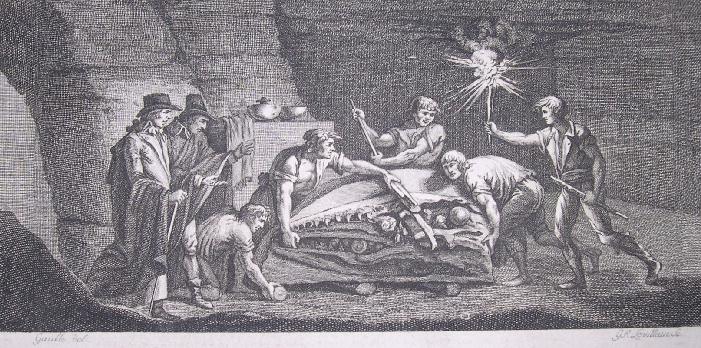
A Mosasaurus skull found in a quarry, thought to be a whale’s for quite a while.
Dubay moves forwards into the histories to the Bone Wars, an event that, in existing, debunks his arguments.
Marsh is said to have discovered over 500 different ancient species including 80 dinosaurs, while Cope discovered 56. Out of the 136 dinosaur species supposedly discovered by the two men, however, only 32 are presently considered valid; the rest have all proven to be falsifications and fabrications! None of them once claimed to find a complete skeleton either, so all their work involved reconstructions.
Even getting things wrong here, Dubay can’t seem to realize that this support dinosaurs existing. If it were all a fraud, why would anybody bother declaring any of these entirely fabricated animals invalid? The more the merrier, after all. And if they did care for accuracy, why did 32 of the dinosaur species involved get to stay? Perhaps because they are real?
In reality, what happened with Cope and Marsh wasn’t them just making stuff up willy-nilly. Instead, it was a case of rampant splitting. In biology, lumpers are taxonomists who tend to see less numbers of overall taxa, while splitters see more. For example, on the extreme ends, a lumper might say there is only one species of giraffe in the world, while a splitter could argue that there are actually 7. While in this case, there is evidence to go both ways, the Bone Wars splitting was down to the cynical desire to have discovered more dinosaurs than your rival.
The best example is Triceratops, which most of you probably know quite well. It was a large dinosaur from the late Cretaceous with three horns on its face. Good stuff. Charles Marsh was not the first man to discover or describe Triceratops bones, but he did find more than anybody else had before, including many fragmentary and complete skulls. Based on minor differences, many of them caused by outside factors like preservation conditions, he separated Triceratops into 10 different species. Later paleontologists determined another 6.
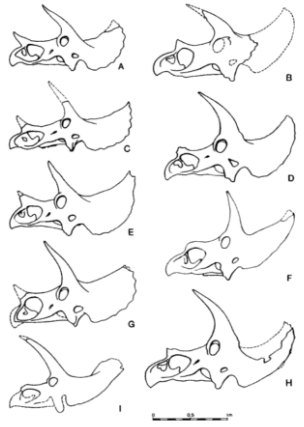
A diagram of Triceratops type specimens, each initially representative of a different species. Ostrom and Wellnhofer 1986.
Later studies concluded that there wasn’t enough anatomical difference between these skulls to say they were different species, and today, only two are recognized. For Eric to be correct, these skulls would have to be determined to be fakes, or better yet never existed. Unfortunately for him, they very much do exist, and it is their direct examination of the extant skulls that led modern scientists to drop the extras.
The dinosaurs aren’t going away Eric. There’s not less of them, there’s just less categories.
In fact, to this day no complete skeleton has ever been found, and so all dinosaurs are reconstructions.
Oddly, Eric contradicts himself here. If these finds are fake, why not simply fake some complete skeletons? Of course, he vaguely approaches something resembling reality here. Complete finds with every single skeletal element are pretty much unheard of due to a variety of factors. Scavengers, natural decay on the surface, and early exposure of bones can all cause elements to be lost. However, two factors make this issue significantly less of a problem.

The first is that sometimes, we get lucky. This is Sue, a Tyrannosaurus rex not famous just for her size but for her completeness. Only the known bones of Sue are represented here; she’s only missing a few foot bones and some vertebrae. Did it still take reconstruction to put her together properly? Sure. Bones become somewhat disjointed even when you do have all of them, and sometimes it’s hard to know exactly how an animal could have been positioned in life. This is how we got the “tripod” posture in so many depictions of theropods. Without a modern reference, it was assumed that they stood much like kangaroos, the only long-tailed bipeds of our day.
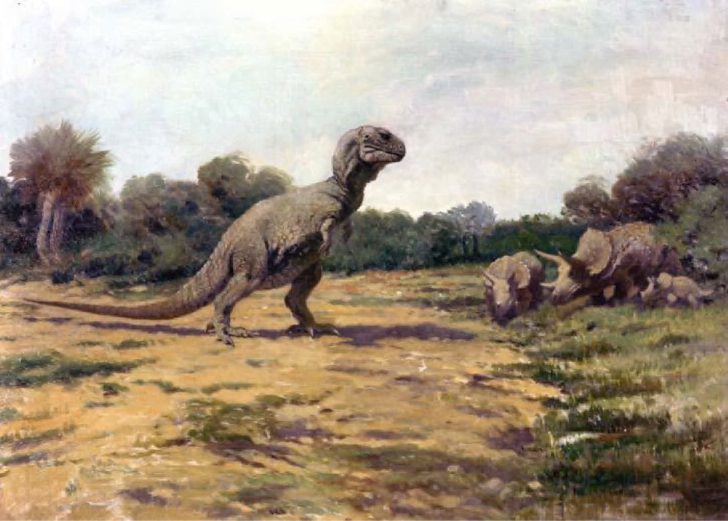
Charles Knight’s depiction of a tripodal Tyrannosaurus from the early 20th century. This look stuck around for decades!
If you aren’t so lucky, Eric would say you’re completely out of luck. Most finds aren’t more than 50% of a skeleton. How do you reconstruct a whole animal from that? Basic comparison. If you’re finding enough partial skeletons, you can compare the parts you’ve got. If one skeleton is just a femur, a pelvis, a skull and part of the spine, and the other is the whole spine, a few skull bits, and the front limbs, you can compare the parts that match up and make a more complete skeleton between them. This isn’t guesswork. I myself have learned a lot of the tricks people use to determine if two similar bones are from the same species. Bones have more features than a lay audience gives them credit for.

An example of complex bone anatomy, this one not even including several features.
This can go for related species as well. There are several dinosaurs, as Eric says, that are based off of very fragmentary remains, but their reconstructions are based on more than just guesses, and the literature is honest about how speculative they will remain until more evidence is found. If you find the teeth of an unknown theropod, you still know that it is a theropod. You can guess at a likely size assuming its teeth weren’t especially proportionately large or small, and you know it will be bipedal and have an elongated body like all theropods. The guesswork involved isn’t just making stuff up like Dubay seems to believe, or at least pretends to.
There is pressure for academics to publish papers. Museums are in the business of producing displays that are popular and appealing. Movie producers and the media need to produce material to sell to stay in business. The mainstream media loves to hype alleged dinosaurs finds. Much is to be gained by converting a bland non-dinosaur discovery, of a bone of modern origin, into an impressive dinosaur find, and letting artists’ interpretations and imaginations take the spotlight, rather than the basic boring real find.
Here, Dubay quotes one of his very few sources in the article, a more mainstream (IE recognizes that the world is round, as far as I can tell) fundamentalist Christian who also disbelieves in dinosaurs. Many of these are actual problems in the reporting of finds. I’ve never seen a non-dinosaur find turned into a find of dinosaurs (with the exception of non-dinosaur animals like pterosaurs being referred to as dinosaurs) but sensationalizing every theropod as bigger and scarier than it really was is a thing.
However, this impact is found mostly on the non-science side of things. Dubay and his source both make the mistake of seeing science as a monolithic block. In reality, the more popular and important your find is, the more attention it will draw from those who will be able to steal that attention by debunking it. If you get too carried away with your speculation, it may well capture the public’s imagination, but it isn’t very likely to be taken seriously in the scientific community.

A trunked sauropod, rejected due to the evidence. What evidence were people arguing about if no skulls existed to compare?
In other words, Museum personnel work with plaster and other materials to transport and fabricate skeletons and missing or incomplete bones all the time. In fact, the huge “dinosaur bone” displays found in museums across the world are admittedly carefully prepared fakes!
This is a major part of Dubay’s argument, possibly the most major. After all, the easiest counter to his arguments from a layman’s perspective is “of course dinosaurs are real, just look at the bones in a museum”. He needs to make this claim to keep his ideas afloat. It’s a shame he’s wrong. It is true that many of the fossils you see in a museum will be models, but many of them are actually real fossils. An article by the Field Museum explains the difference between using models and using the real fossils.

To the left, Sue, a Tyrannosaurus that is almost entirely real fossil bones. To the right, Maximo, a Patagotitan that is entirely made of casts and sculpted replicas.
Using fake fossils isn’t an attempt to fool anybody, hence why museums are so up front about which of their fossil displays are fake and which ones are real fossils if you just ask. The majority of replica fossils wouldn’t even be possible with no base to work from, as when possible, they are made from casts of the original. This is how model versions of Sue have made their way to many museums that could never afford many large fossils. Casts and sculpted bones can also be touched by visitors, which is unwise with most actual fossils.
What would be the motivation for such a deceptive endeavor?
Oh this is gonna be good.
Obvious motivations include trying to prove evolution, trying to disprove or cast doubt on the Christian Bible and the existence of the Christian God, and trying to disprove the ‘young-earth theory.’
Interesting, but as we already tackled the history of dinosaurs, this seems unlikely. Worse for this claim, other young earth creationists don’t see dinosaurs as a threat to their ideologies, whether they should or not. Groups like Answers in Genesis see dinosaurs as useful tools for reaching the young, calling them “missionary lizards”. Now, they’re wrong in their own ways, but they clearly don’t see dinosaurs as any sort of great challenge to their conception of a young earth. And of course, several modern Christian groups don’t see an old earth as contradictory to their beliefs at all, even ones known for being devout like the Jehovah’s Witnesses.
Another problem with dinosaurs is their unnatural structural dynamics. Many dinosaur skeletons and reconstructions feature bipedal monsters like the T-Rex with a forward-leaning torso and head far larger and heavier than its counter-balancing tail.
Alright, here’s where we get into some proper juicy biological stuff. Eric is speaking my language! He’s not fluent and he’s got an incomprehensible accent, but he’s speaking it. So Eric postulates that theropods, in particular Tyrannosaurus rex, have unworkable body plans, with heads too big for their bodies. He doesn’t provide any math for this, he just kinda spitballs it. We’ll start with our own very basic explanation, then go into the bigger details.
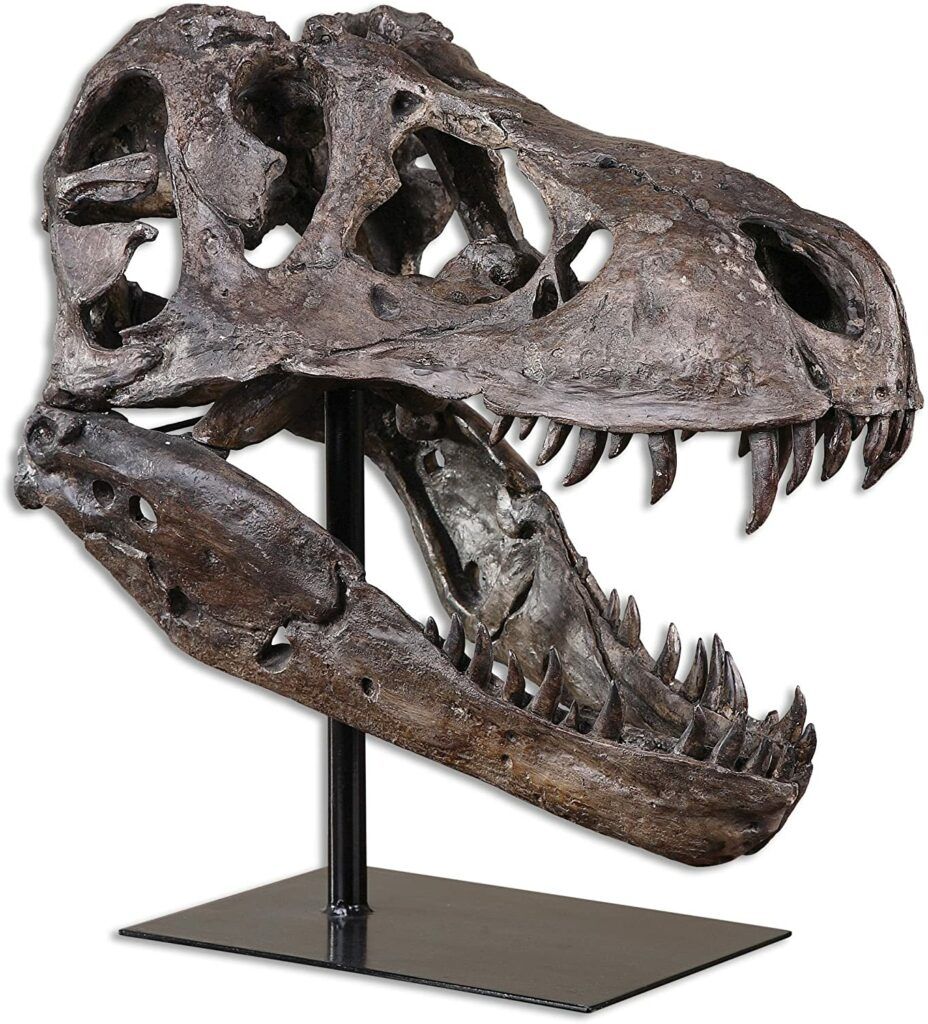
Looking at the head end, we notice that while massive the skull of a Tyrannosaurus is also full of holes. While the skull remains strong, the holes in the cranium also cut down on the load the animal had to carry around. Less obvious to the naked eye is how big the tail would be. Here we must move to to scientific sources, such as this one. W. Scott Persons and Philip J. Currie describe the evidence for a massively muscular tail for theropods and in particular, Tyrannosaurus rex.
Musculature leaves marks on the bones where it attaches. If an expert found the bones of a bodybuilder, they would be able to point out the muscle attachment points and determine that the individual had more musculature than average. In the case of species-wide muscularity, you get even more obvious signs as an entire species’ anatomy is made to handle more muscles. Using these signs, it has been surmised that Tyrannosaurus rex had a meaty tail even for its clade, providing plenty of counterbalance for its large head.
People’s view on the existence of dinosaurs is based not on firm evidence, but on Hollywood fixated artistic impressions. Documentaries colorfully illustrate each dinosaur’s characteristics, like colors, weight and muscle mass, but Don Lessem (advisor for Jurassic Park) admits that this is pure guesswork – consider for instance the question of how much these dinosaurs weigh.
Dubay brings in another dinosaur denier source to make superficially true but meaningless points. People’s views on the existence of dinosaurs isn’t based on Hollywood, but their impressions on dinosaur appearance and behavior definitely are. I have talked myself about how influential Jurassic Park was. Linked here is a toy on Amazon depicting Dilophosaurus with a frill, something invented by the movies. Search google and you will find dozens more. The question is why pop culture depictions of dinosaurs disprove dinosaurs. We don’t know what Jesus looked like (and most of our depictions of him are just as fanciful as that absurd toy), but most flat earthers wouldn’t dispute a historical Jesus.
One of the main reasons that evolutionists “needed” the existence of dinosaurs was to answer the complicated problems present in the theory of evolution including: sea-dwelling animals evolving into land-dwellers; reptiles evolving wings, feathers, flying and becoming birds; as well as other reptiles evolving warm-blood, live births, breasts and becoming mammals.
This is an odd claim, because of all these transitions, only some of these have anything to do with dinosaurs. I’m genuinely not sure how inventing dinosaurs would help you explain early synapsids becoming mammals. I’m also not sure how dinosaurs would explain transition from other reptiles into birds, given that at the initial time of their discovery, nobody thought that they were related. It’s a worthless claim, and I only bring it up to demonstrate how bad Eric is at establishing motive.
Many professionals and experts in the field have disputed such findings as often as they have been presented, however. Dr. Storrs Olson, a Smithsonian Institute Scientist, wrote, “The idea of feathered dinosaurs and the theropod origin of birds is being actively promulgated by a cadre of zealous scientists acting in concert with certain editors at Nature and National Geographic who themselves have become outspoken and highly biased proselytizers of the faith. Truth and careful scientific weighing of evidence have been among the first casualties in their program, which is now fast becoming one of the grander scientific hoaxes or our age.” (Bold added by Dubay)
Eric finally quotes an actual expert, Dr. Storrs Olson. Olson was, at the time of his retirement in 2008, the curator of birds at the Smithsonian. This man knew his stuff when it comes to birds, so as a disputer of the dinosaurs to birds theory of bird origins, he actually has some credibility. However, what he isn’t an expert on is bird origins. I can’t find a single paper of his dealing with birds earlier than the Eocene, long after they had diverged from their ancestors. Here he responds to Archaoraptor, a hoax where a primitive bird’s bones were mixed with parts from feathered non-bird dinosaurs, which… doesn’t help Dubay’s case, does it? The tail of Archaoraptor was in fact from a then-unknown dinosaur that proved to actually be a fascinating bird relative itself!
Part of Olson’s issue is that he was vehemently against the idea of dinosaurs as ancestors of birds, but to my knowledge, never provided an alternative, something pointed out by a response to his open letter, translated from Spanish:
The archaeoraptor scandal has revived the alleged controversy surrounding this hypothesis. And we say supposed because the opposing scientific sectors still do not provide evidence for a credible alternative.
Most of his arguments, while potentially valid at the time, have been disproven by progress in the field. He complains of feathered depictions of dromeosaurs, but not only were these proven by a part of Archaoraptor, the tail of Microraptor, a very thoroughly feathered dinosaur that had wings not just on its arms but its legs.
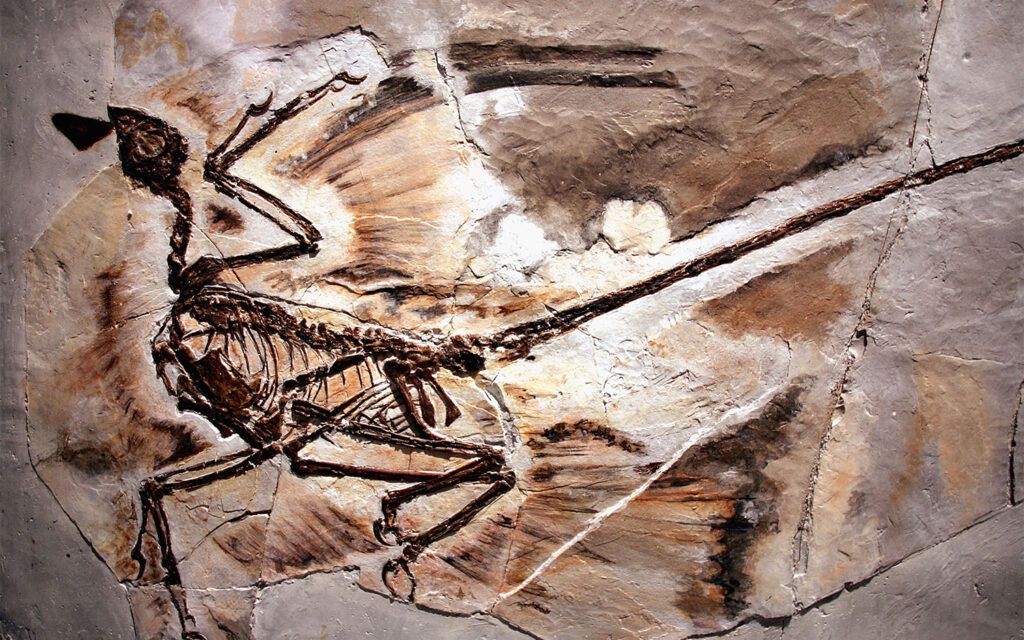
A full Microraptor fossil, complete with feather impressions. Dr. Olson frequently claimed that there were no proven fossils of dinosaurs with feathers, but that has been repeatedly disproven at this point.
Continuing on the front of attacking dinosaur to bird evolution for some reason, perhaps distracting us from how little material he actually has, Eric relies on his own words, and in doing so either lies openly or fails to comprehend simple language:
In the 1990s many fossils with feathers were supposedly discovered in China (suspiciously close to the Zigong Dino Ocean Art Company), but when examined Dr. Timothy Rowe found the so-called “Confuciusornis” was an elaborate hoax.
Dr. Rowe’s work is actually very interesting and very much does not help Dubay, so let’s talk about it. Dr. Rowe’s team (scientists rarely work totally alone!) describe a new method of using x-rays to scan reconstructed slabs of fossil-bearing strata to find where there are discontinuities, both accidental and purposeful. Basically, when these fragile fossils are being extracted, they are often damaged, and those seeking profits will sometimes include pieces from fragmentary slabs to finish the product. These frauds are possible to catch via traditional analysis, but those methods usually damaged the fossil in proving its validity, while Dr. Rowe’s method does not. As for Confusciuornis, the paper on this new technique studies a specimen as a test subject:
The first is a specimen of the primitive bird Confuciusornis56 that was shattered and reconstructed with relatively minor errors.
Forgive me if I’m wrong, but “relatively minor errors” does not translate to “elaborate hoax”. Dr. Rowe did suggest that Archaoraptor was a fake before it was revealed in National Geographic, but he never “debunked” Confusciuornis. Dubay using Archaoraptor as a major part of his argument was already a mistake, as it being so quickly debunked as a fake proves our modern skills at detecting fraud and the scientific community’s willingness to attack it. Targeting Confusciuornis was even more foolish, as most creationists just declare it a fully modern bird and move on, which isn’t true but is smarter than specifically calling attention to it through lies. Worse still, it forces him to contradict himself only a few paragraphs later.
Other species like Confuciusornis, Liaoningornis, and Eoalulavis have all been found to be contemporary with the Archaeopteryx and are indistinguishable from present-day birds.
Now hold on, I thought that Confuciuornis was a hoax? How is it also now evidence against Archaeopteryx? Well let’s ignore that and examine his claim here. First issue is that Dubay is using an outdated date for these finds that placed them in the late Jurassic with Archaeopteryx, which wouldn’t be as much of a problem as he pretends, but also isn’t accurate. Archaeopteryx lived about 150 million years ago, while the three more modern-looking birds were all from the early Cretaceous about 125 million years ago, giving us 25 million years between the groups.
Furthermore, remember what I said about creationists being wrong that Confuciuornis was a modern bird? That’s because of a few special features. Externally, it was quite like most modern birds, but it still had some odd features. Most of these come down to extremely technical terms, so I will abridge it to this; they still had fingers. There are very few birds today who even have open claws, and none that have their hands with full, functioning fingers, and yet all three of these birds did.

Notice that there is a large claw on the wing. Almost no modern bird has this feature, and no bird has its fingers totally unfused like that.
Dubay finally makes his last relevant point, or rather, lets somebody more qualified make it for him:
Alan Feduccia from University of North Carolina, one of the most famous ornithologists in the world stated, “I’ve studied bird skulls for 25 years and I don’t see any similarities whatsoever. I just don’t see it. The theropod origins of birds, in my opinion, will be the greatest embarrassment of paleontology of the 20th century.”
As is standard of Dubay’s expert quotes, Dr. Feduccia actually isn’t very useful to Dubay’s cause. Unlike Dr. Olson, Dr. Fedducia is an expert on bird evolution, even if he comes to different conclusions about it than most members of the scientific community. As such, if Dubay’s goal was just disproving a dinosaur-bird link, this would be a good man to quote. As is, Feduccia is terrible for Dubay’s goal of proving there are no dinosaurs, as he uses certain dinosaurs as evidence of his theories. He believes that many groups of supposed dinosaurs are actually secondarily flightless birds, such as Caudipteryx and other relatives of the more famous Oviraptor. His arguments, relying on detailed knowledge of dinosaurs and how they are distinguished from all other life on the planet, disprove Dubay’s article all without even trying. Ouch.
And… that’s how it ends. There’s more where Eric Dubay rambles about how flies couldn’t evolve, but it’s totally irrelevant to the topic. The structure of the article is as bad as its arguments, if not worse, to the point where I fully expected him to go back to talking about dinosaurs directly, but he never managed to find a real link between the topics. It’s a shame because it means his article ends on its weakest points, as disconnected from the subject as his beliefs are from reality.
